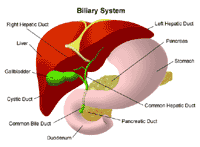Hepatitis B
 |
| Click Image to Enlarge |
What is hepatitis?
The liver is one of the organs that helps with digestion but is not part of the digestive tract. It is the largest organ in the body and carries out many important functions, such as making bile, changing food into energy, and cleaning alcohol and poisons from the blood.
Hepatitis is inflammation of the liver that sometimes causes permanent damage. It is most commonly caused by viruses, bacteria, certain medicines, or alcohol. It may also be caused by certain diseases, such as autoimmune diseases, metabolic diseases, and congenital (present at birth) abnormalities (for instance, biliary atresia or Wilson disease). Generally, symptoms of hepatitis include fever, jaundice, and an enlarged liver. There are several types of hepatitis.
What is hepatitis B?
Hepatitis B (HBV) is a blood-borne microorganism transmitted by exposure to the hepatitis B virus through infectious body fluids or blood.
Hepatitis B is one of the most frequently reported, vaccine-preventable diseases in the United States. It is estimated that 3,000 to 5,000 deaths will occur each year from a chronic HBV infection, and an estimated 800,000 to 1.4 million people have chronic hepatitis B.
What are the symptoms of hepatitis B?
Hepatitis B has a wide range of symptoms. It may be mild, without symptoms, or it may cause chronic hepatitis. In some cases, hepatitis B can lead to full-blown liver failure and death. The following are the most common symptoms of hepatitis B. However, each individual may experience symptoms differently. Symptoms may include:
-
Loss of appetite
-
Nausea
-
Fatigue (feeling very tired)
-
Vomiting
-
Jaundice (yellowing of the skin and eyes)
-
Dark urine
-
Clay colored or light colored stools
-
Abdominal (belly) pain
-
Occasionally, skin rashes, arthralgias (joint pain), and arthritis occur
-
Enlarged liver
The symptoms of hepatitis B may resemble other medical conditions or problems. Most children, 4 years or younger, and newly infected immunosuppressed adults are asymptomatic, whereas 30 to 50 percent of people, 5 years and older, have initial signs and symptoms. Always consult your doctor for a diagnosis.
How is hepatitis B transmitted?
Transmission of hepatitis B virus occurs through blood and body fluid exposure, such as blood or saliva. Needle sticks, sharp instruments, sharing items (for example, razors or toothbrushes) with an infected person are primary modes of transmission. Infants may also develop the disease if they are born to a mother who has the virus. Infected children often spread the virus to other children if there is frequent contact or a child has many scrapes or cuts.
Who is at risk for hepatitis B
One out of 20 people in the U.S. will develop hepatitis B at some time during their lives. The following describe persons who are at risk for developing hepatitis B:
-
Children born to mothers who have hepatitis B (the illness may present up to five years after the child is born)
-
Children who are born to mothers who have immigrated from a country where hepatitis B is widespread, such as southeast Asia and China
-
People who live in long-term care facilities or who are disabled
-
People who live in households where another member is infected with the virus
-
People who have a blood-clotting disorder, such as hemophilia
-
People who require dialysis for kidney failure
-
People who have a job that involves contact with human blood
-
People who received blood transfusions or blood products before the early 1990s
A vaccine for hepatitis B does exist and is now widely used for routine childhood immunization.
Prevention of hepatitis B
A vaccine for the prevention of hepatitis B is available. Given in three shots over a period of time, the vaccine is suggested for everyone age 18 years and younger, as well as for adults over age 18 who are at risk for the infection.
How is hepatitis B diagnosed?
In addition to a complete physical examination and laboratory tests for blood and urine, diagnostic procedures for hepatitis B may involve a liver biopsy (a procedure performed to remove tissue or cells from the body for examination under a microscope).
Treatment for hepatitis B
Specific treatment for hepatitis B will be determined by your doctor based on:
-
Your age, overall health, and medical history
-
Extent of the disease
-
Your tolerance for specific medications, procedures, or therapies
-
Expectations for the course of the disease
-
Your opinion or preference
Treatment may include biological therapy with interferon. Currently, there is no cure for hepatitis B. Prevention is crucial.